Recently David Sylvian reflected on the various live outings he has made since his first solo tour, In Praise of Shamans, in 1988. His recollections were particularly warm in relation to the Everything and Nothing tour which included stints in both 2001 and 2002. It was, he said, ‘enjoyable due to the fluency of the musicianship and the shared camaraderie.’ The musicians had evidently enjoyed their time spent together: ‘Socially speaking, everyone found their comfort zone and stayed within it.’ (2021)
It’s an outcome that is all the more remarkable for the fact that several of the line-up hadn’t met Sylvian until the rehearsals commenced just a few weeks before they were due to take to the stage together for the first time. The singer sought recommendations from friends for his small touring band. Keith Lowe, who played upright and electric bass for Everything and Nothing, has attested to the fact that Bill Frisell put his name forward (see ‘Cover Me with Flowers – live’). Keith played with Bill in the ensemble known as The Willies, and it was their bandmate and violist Eyvind Kang who would suggest the name of Timothy Young for the role of lead guitarist for Sylvian’s tour.
‘I was recommended to David by Eyvind and by his girlfriend at the time, Angela Lopes,’ Tim explained to me. ‘They told me they had been hanging out with David at an ashram, following Amma [Mata Amritanandamayi] and that they had given him my number. He called, asking me to send some examples of my music.’ The fledgling project might easily have slipped from the guitarist’s grasp, however. ‘I put together a CD of some things I had done. I can’t recall what I put on there, but he told Angela that it was awful and he didn’t think I’d be a good fit! She lobbied vigorously for me, saying that I’m much better than whatever examples I’d given him, and pointed him to Sweeter than the Day by Wayne Horvitz which features my playing in a more flattering light [and also displayed the talents of bass player Lowe]. Since he trusted Eyvind and Angela’s opinions, he took the chance with me and hired me for the tour.’ Some time elapsed before Sylvian’s invitation was extended, during which period the singer was being convinced about Tim’s talents and revisiting that sample CD, which he subsequently spoke about much more positively! ‘I’m forever grateful to Angela and Eyvind for their support,’ says the relieved guitarist.
Young had knowledge of some of the body of work that would be the focus of the retrospective live shows. ‘I had listened to Secrets of the Beehive quite a lot since 1991, when two different friends, whose musical tastes I greatly respected, had turned me on to it. I loved the romantic, dreamy, epic sound of it. His voice and his poetry struck me deeply. But I wasn’t familiar with much else. I also had a cassette with some live Sylvian/Fripp stuff, compiled by my friend.’
Before rehearsals began, the band were provided with some guidance to aid their preparation. ‘I was given a list of songs we’d be starting with. I burned a CD with all the music and listened constantly while going about my life, letting the music percolate into my subconscious. This is how I learn best. Funny though, since I was listening on a sh*tty little boombox, I thought most of the sounds I was hearing were synthesisers, not guitars (I was wrong) so I didn’t learn any specific guitar parts.
‘It wasn’t until I got on the plane for Boston that I listened in headphones and realised there were TONS of guitar parts going on. All very specific and undoubtably integral to performing these songs. I panicked and spent every waking hour before and after rehearsals transcribing parts, memorising and practicing them in my room all night, trying to stay one step ahead of the rehearsals. I managed to get it done, but the first week was very stressful!’
Once this initial scare had been negotiated, Tim relaxed into the band’s preparatory sessions at Sylvian’s home in New Hampshire. ‘That was a wonderful time. We had three weeks of rehearsal in preparation for the five-week tour of Europe and Japan. We all stayed at David’s house, which he had purchased from Amma, who had used it for an ashram. The original house was built in the 1700s, I think, with an addition made in the 1980s. So it was like two houses – one historic and one modern.
‘The modern section had a sun room, big dining room and meditation hall. There was a big yard with old trees. A wonderful place to dwell. They had a nanny for their three kids who also cooked meals for us. She was a great cook and we shared many delightful meals together. Living and rehearsing together in this remote location reminded me of being at camp – music camp. So we all took to calling it “Band Camp.” I should’ve trademarked the name!
‘We rehearsed in the barn on the property. This also dated back to the 1700s and was very rustic – dirt floor, hewn timbers, uninsulated. We would practice for a few hours in the morning, have lunch, then practice a few more hours in the afternoon/evening, totalling about eight to ten hours a day. Though it was quite a bit of work, it didn’t feel at all tiresome because of the lovely meals and wonderful surroundings. We got very comfortable with each other in a short period of time, the way kids at camp forge friendships. BAND CAMP!!
‘I loved it there. Every day I would do some exercise in my room then take a jog down the road about a mile to the little town of Temple, where I would buy some cigarettes at the general store. I fancied myself quite clever, balancing health and vice in this way! There is a lake nearby on which we took a canoe out one night. Lovely country living. One of those places I could see myself staying for a long, long time.’
So what was it like in the rehearsal room, and how daunting was it to take on the guitar parts originally performed by the likes of Robert Fripp, Marc Ribot, Bill Nelson, Steve Tibbetts, Bill Frisell, and of course David himself? ‘As I mentioned earlier, I had initially glossed over the guitar parts. I approach music from a jazz perspective, where I learn THE SONG – the melody, harmony, inner workings of it. I could perform countless variations of songs, but I tended to focus less on the specifics of parts and production. I’ve since learned a greater appreciation for those things.
‘So I made the horrific mistake of assuming, we’d “re-create” the songs when we got together and figure out who was gonna play all those parts. Since a lot of the guitars in his music are very processed and don’t sound like traditional guitars, I had assumed a lot of them were synth parts. I did, however, bring a large pedal board which covered the basic categories of effects: distortion, delay, modulation, dynamics, reverb, etc. From these basic tools (and a lot of late-night scrambling on my part) I was able to arrive at sounds and parts that I’d like to think captured the essence of what was on the recordings.
‘I obviously respect all the giant talents that have played on David’s records. I was a fan of Fripp since the age of thirteen. I’ve always made a point of not caring TOO much, however, about the genius of others, as that can be debilitating. So I found a balance of presenting the essence of those parts which were integral to the music, while leaving room to relax and be myself.
‘I don’t recall David having any specific vision for reinterpreting the songs. The very nature of the band being made up of fresh faces (besides the lovely Steve Jansen) was enough to provide a fresh approach. It was more a matter of finding something that worked and felt natural, finessing each song until it felt right. So no blanket approach or overarching concept. Just listening and tweaking until it felt right. I didn’t get the sense that David was trying to push forward artistically in this retrospective, but rather present the songs in a way that felt natural and not contrived.
‘[Sound engineer] David Kent and Claudia Englehart (who mixed our monitors) were absolutely wonderful. They were there for the whole time of rehearsals, dialling in the sound.
‘It was clearly a happy time in David’s life. He and Ingrid Chavez seemed happy and his sweet little children were running about this idyllic property, watched over by their mother and their lovely nanny. He’d spend a portion of every day in the meditation hall, praying and meditating. Obviously a deep man, full of emotion, he had a feeling of lightness. His wit is so sharp and his command of language so strong that I recall thinking, “I’d hate to be on his bad side!” Fortunately we were all good and we shared many laughs along the way.’
Until Tim reminded me, I had completely forgotten how the start of the tour was disrupted by world events. ‘We were supposed to start in Japan on September 17th, 2001. We all flew home from New Hampshire (out of Boston) on September 10th and 11th. Claudia Englehart’s flight into NYC arrived right before the first plane hit the World Trade Center tower. At home in Seattle, I watched the news in horror and shortly after, received a call from David’s management, saying plans were changing. The Japan leg of the tour was put off till after Europe and we started in Portugal instead. It was strange taking flights in the weeks following 9/11. Airports were eerily empty and everyone was visibly nervous. We had entire rows to ourselves on planes…’
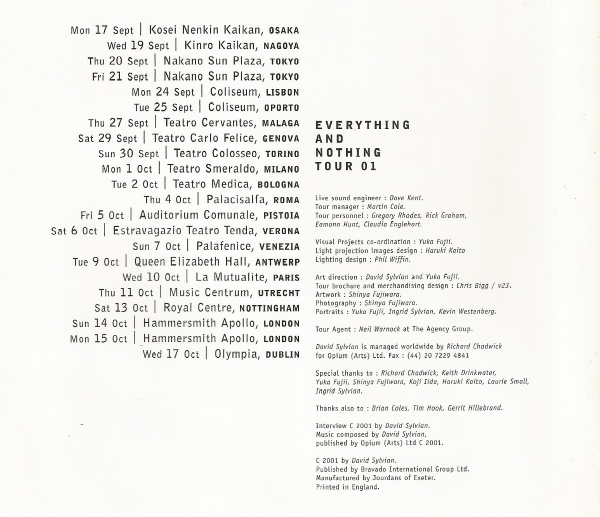
Once the band was able to take the stage, the experience was a positive one. ‘I loved performing several of the songs. ‘Blackwater’ was a highlight for me because I sang back ups and harmonising with David amidst such sonic splendour gave me chills night after night. Sometimes playing a great song like that can feel like you are driving in a car you could never afford. It’s such lush pleasure to be inside of it and everyone you drive by thinks you’re a millionaire and super cool!
‘I loved playing ‘Orpheus’ because the part on that is so epic and expansive and while I never quite achieved that level of beauty, it was fun to try every night!’
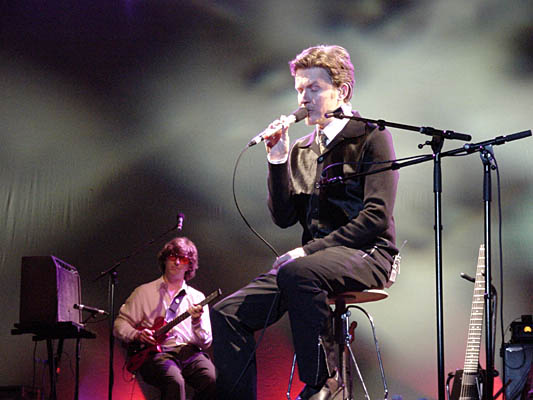
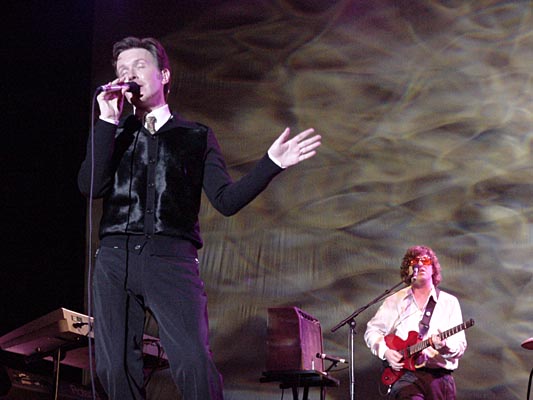
One track from the never-before-toured Dead Bees on a Cake was made for the lead guitarist to shine – the melancholy blues of ‘Midnight Sun’. On stage the song began with the chug of the bass-line performed on upright acoustic by Keith Lowe. Tim: ‘It was really fun because over the course of the tour, I started playing with a fun aspect of the Fender Deluxe Reverb amp – the reverb tank itself. If you jostle the amp violently, it causes the springs in the tank to clank together and make a sound like thunder. So during my solo, I’d go to the amp and shake it, making these explosions to great dramatic effect. David seemed to enjoy this, as did the audiences.’
The sound team of Dave Kent and Claudia Englehart were as integral to the success of the tour as the musicians themselves. ‘They took the monitor mixing board with us on tour, since having good sound was so important to David. He does sing very quietly and in a low register, so we used “in-ear” monitors to keep the stage volume at a minimum. My first time doing it, it took some getting used to. I have spent most of life playing in clubs where the ambient sound and the volume very much influences your experience of the music. In-ears can feel a bit sterile, as there is only the sound of the instruments and voice (unless they pipe in audience ambience as they did in Japan). The upside of this is that with our own monitor board, monitor engineer and in-ears, it sounded EXACTLY the same every night and enabled us to get used to the sonic environment and have fun with it.’
As fans we noted some changes to the set-list as the band went from city to city and country to country. ‘Wanderlust’ started off on the list but disappeared, ‘Red Guitar’ made an appearance mid-way through the European shows and ‘Buoy’ on the final US leg. ‘We had time at soundcheck to play through songs and David would make adjustments, cutting or adding songs, as you mentioned. The developments happened naturally over the course of the tour, as Matt Cooper would take a particularly epic solo on a song, that song would become a feature for him, getting longer and more elaborate from one night to the next. Things that felt especially good would be amplified and encouraged, so the set grew and morphed organically as we found our connection to the music and to the audiences.’
As he had done back in New Hampshire, Sylvian took care to keep some equilibrium in his existence whilst on the road. ‘He had time scheduled in each day for meditation while on tour. I think he had two rooms at every hotel – one for sleeping and bathing, one for prayer and meditation.
‘I initially approached all this with an air of caution, being careful to respect his religious pursuit, but quickly learned that he was not rigid or humourless about it, only devoted. Before long, I was cracking my usual dumb jokes. I had decided this would be a good time for me to spend my down-time reading philosophy and such, so as to fit in. I brought a bunch of books on history and philosophy and carried them in plastic grocery bags, for which David made fun of me. He eventually bought me a fashionable bag to carry them in, so as not to embarrass the group as we made our way through airports and hotels!’
Tim also felt the visceral impact of Sylvian’s nightly song of praise, performed as part of the set’s encore. ‘I also loved ‘Bhajan’ because I played slide guitar and got really into the beautiful melody. When people play those frequencies together, it has a powerful effect on the body. I loved getting the feels every night during that song.’
Differing audience responses across the continents were a new experience. ‘European audiences were very enthusiastic, being big fans of David. I was familiar with European concert halls from playing jazz festivals before. I love playing in those beautiful old venues. I had never played in Japan before, and David prepped us warning us that while the audiences are very much into the music, they show this by being quiet and respectful. This can feel as if they’re not enjoying it, coming from a culture where we hoot and holler to show our enthusiasm. They even set up a mic facing the audience which they would pipe into our ears between songs, so that it felt more alive. Japanese audiences let the very last note fade all the way out before showing their love with a gently patter of light applause. Very interesting!’
Following the success of the European and Japanese adventure, it was decided to add some gigs the following year in Sylvian’s adopted homeland. Writing in the US edition of the tour programme, Sylvian said: ‘What grew out of the twenty day rehearsal period prior to the commencement of the tour was a beautiful chemistry between musicians and technical staff alike. A delicate balance that in my experience is notoriously difficult to achieve. As the original tour came to an end in Osaka, Japan in November last year, and as the familial bonds of this micro-community took hold, there was a desire on the part of all concerned to prolong the experience. It’s now my pleasure to bring the tour to the shores of America where, in fact, the journey began.’ (2002)
There was more than a six month gap between the final show of 2001 in Japan and the first of the US concerts the following year. How did the band get back to the same level where they had left off? Tim: ‘We had another week of rehearsals in Temple to blow the rust out of the pipes. We didn’t really change much, just got back into the flow. David is a smart performer and he knows not to fix what isn’t broken. The music kept developing organically during the three-week run in the US.’
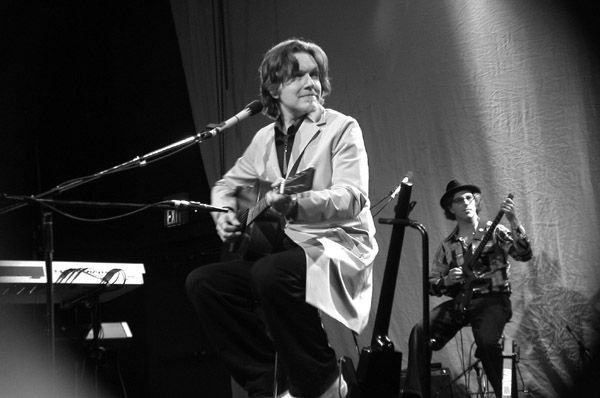
My own experience of the tour comprised of two nights in London. For Tim Young, there were a number of highlight shows and special memories made. ‘Hammersmith was great. My wife Eryn had flown to London to join us for a couple of the gigs. My cousin lives in London, so I was able to see him, and at the after-party I met John Paul Jones who was in attendance. Crossed that off my list!
‘After that we played in Dublin at the Olympia Theatre which had these steep balconies rising up above the stage. It was a memorable performance in a historic venue and afterwards my wife and I went dancing, drank too much and I carried her back to our hotel on my shoulders, as she was drunk in high heels and couldn’t navigate the cobblestone streets. Great fun. I was quite strong, apparently! New York Town Hall was very special playing with Sakamoto. Japan was special, as I had never been there. Experiencing Tokyo and Osaka was a real treat.
‘I absolutely adored this experience. It was the biggest, most “pro” level tour I had done and to this day, the only one. I’ve spent years in and out of tour vans and planes, touring with singer songwriters but never again on that level. It was a treat on the logistics side but more importantly a deep and humbling honour to be a part of bringing David’s music to audiences around the world. He is such a singular, powerful artist and I’ll forever be grateful that he gave me the chance to be in the band. We gelled fabulously, with Keith Lowe, Matt Cooper, Steve Jansen, David and I all contributing to a cohesive musical experience and having lots of fun, good food and laughs along the way.
‘David is in a class by himself, both as an artist and as a singer. His voice is so subdued and gentle but within that quiet realm there is such power and detail. I found myself getting lost in the sound every night. On songs that I sang harmony, I discovered after a while that I needed to sing in an English accent, so the vowel sounds (and subsequent harmonic overtones) would match so that it blended. A fun discovery that has stuck with me.
‘As an artist, David is so heavy. I am still inspired and haunted by David’s work. Every line of his lyrics can stand alone as a poem, so inventive and impactful are the images conjured there. But taken several lines at a time, or as a whole song, they convey so much emotion and depth of experience. Truly staggering. Then the sonic palette, the melodies, the chords. It’s all too much. I’ll never be the same having ridden in that car I can’t afford.’
‘Midnight Sun – live’
Matt Cooper – keyboards; Steve Jansen – drums, percussion, electronics; Keith Lowe – acoustic and electric bass; David Sylvian – guitars, vocals; Timothy Young – guitars, backing vocals.
Music by David Sylvian, Johnny Moore, Charles Brown and Eddie Williams. Lyrics by David Sylvian.
Played live on the Everything and Nothing tour, 2001/2
lyrics © copyright samadhisound publishing
Many thanks to Timothy Young for generously sharing his memories of this tour.
Full sources and acknowledgements for this article can be found here.
The featured image shows Timothy Young (left) and Keith Lowe (right) on stage with David Sylvian, Genova, Italy, 29 September 2001. Photographer unknown.
Download links: ‘Midnight Sun’ – studio version (Apple)
Physical media links: Everything and Nothing – retrospective album (Amazon)
‘I felt very comfortable with the band on the Everything & Nothing tour. There was a wonderful chemistry between the five of us and a simplicity, a directness, in the musical arrangements which kept the material fresh, honest and challenging.’ David Sylvian, 2003
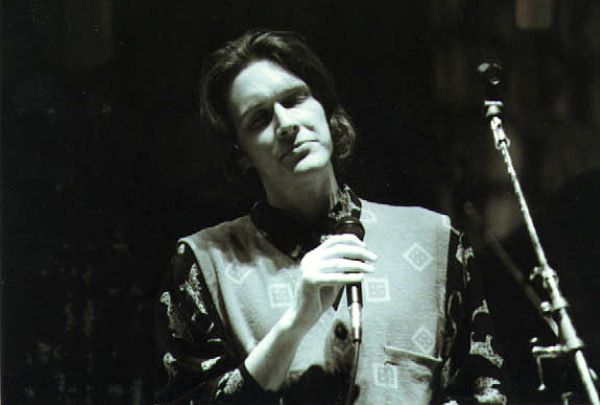
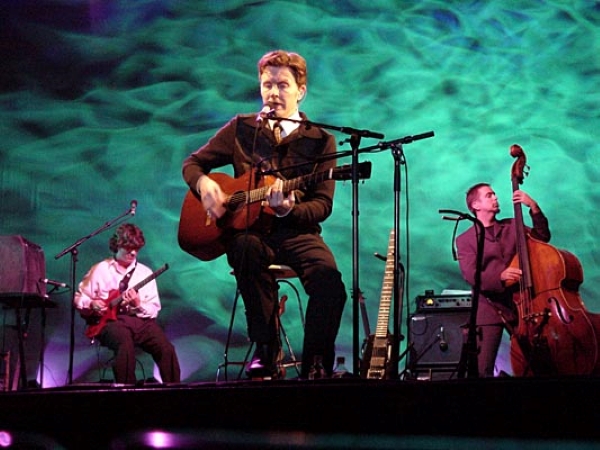
Lovely article: beautiful to read about Tim’s experience!
I adore(d) that tour🤗
Heartfelt thanks to all💖
LikeLiked by 1 person
Great article as always and it is so lovely to hearing about Sylvian in one of his more happier times. I hope he has had many. Thankyou again
LikeLiked by 1 person
As usual, your essay calls to mind concrete memories and gifts us with a deeper comprehension of what we could just perceive as spectators in those days, when no Twitter, Instagram or Facebook interaction was yet possible and the “arastar mailing list” was the only and invaluable resource for being up-to-date about David Sylvian world.
I was really intoxicated by his charisma, so I bought tickets for both the London Hammersmith shows and previous Italy dates in Verona and Venice. About those concerts I do recall not only how David was hitting it off with the band but also the limitless serenity they were able to radiate; not to say the richness and the originality of the setlist, equally picking between the ‘hits’ and his collaborations.
More than twenty years passed, it still seems yesterday.
Thank you, my dear vistablogger.
LikeLiked by 1 person
🤗
👋🏻
LikeLiked by 1 person
Thank you for the comments. I’m glad you enjoyed revisiting experiences of this tour – as did I!
LikeLike
I saw David and his band at the Wiltern Theatre in Los Angeles. The one and only time I have seen him live, sadly. It truly was a sublime experience.
Your article brought back wonderful memories.
I remember he performed “Waterfront” and as he sang the final line “Is our love strong enough?” I turned to see my wife crying.
We are still married by the way. 😉
LikeLiked by 1 person
Thanks for sharing the memory. ‘Waterfront’ was a highlight on that set-list, for sure. Good times.
LikeLike
Beautiful, sweet and romantic moment: you are both very lucky☺
LikeLike
I agree about the emotional power of the track. The way he shoots through and beyond the octave. It is one of the following tracks that I still listen to (mostly) more than once every week. If I placed them in a ‘chart’, that chart would be like this (Sylvian/Japan/Rain Tree Crow/Sakamoto);
1. Some Kind Of Fool
2. Red Guitar
3. Forbidden Colours
4. Waterfront
5. Gentlemen Take Polaroids
6. Cantonese Boy
7. Swing
8. Blackwater
9. The Art Of Parties
10. Quiet Life and, Ghosts…
Speaking of charts. I am a quite recent follower of Mike Read’s Heritage Chart. Many of David’s (and our) contemporaries are ‘popping up’ and over eighty countries regularly vote. Wouldn’t it be great if David put out some work on it? I’m sure it would climb…BW,
LikeLike
Erratum (to mine of the 6th instant):
Citizens of seventy countries regularly vote (Heritage Chart), rather than ‘…over eighty…’
My apology to the VB and BW,
Jeremy
LikeLike